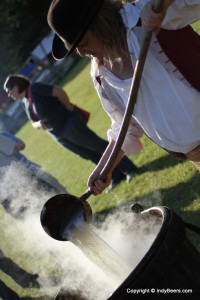Last year we couldn’t get enough gose, a traditional tart-and-salty German ale that suddenly hit shelves en masse with popular canned versions from Anderson Valley and Westbrook leading the charge. But it’s not the only long-lost style to rise from the dead: Today’s most forward-thinking breweries are looking back, referencing historic styles to draw new drinkers.
By culling dusty recipes from European traditions, brewers are unlocking a new world of beer for us (forewarning: these names don’t roll off the tongue as easily as “IPA”): There’s gotlandsdricka, a smoked, juniper-laced farmhouse ale from an island off Sweden, brewed stateside by D.C.’s Right Proper; and kottbusser, a dark East German ale brewed with honey and molasses that’s been revived by Chicago’s Off Color and Loveland, Colo.’s Grimm Brothers. Or pick up a bottle of sticke alt—that’s a darker, higher- ABV version of the copper-colored German altbier (look for Sticke It To The Man, brewed by Missouri’s O’Fallon). Yes, these beers are unfamiliar, but brewers say the styles are as relevant in 2015 as they were hundreds of years ago. After all, there’s a reason they were popular in the first place.
“We have bars that are middle-of-nowhere, crazy biker bars that run through our [historic] beer because it’s drinkable,” says Russell Fruits, vice president of Grimm Brothers, which in addition to its kottbusser bottles a gratzer, a type of smoky wheat ale born in Poland.
Drinkable—and different. As craft beer fans’ palates become more intrepid, some want to see less common styles. Brewers with a detective streak are happy to indulge craft beer fans’ taste for the unusual.
“At the end of the day, I’m a big nerd. I have both this curiosity and this romantic notion about where everything came from,” says Erik Lars Myers of Hillsborough, N.C.’s Mystery Brewing, which eschews flagship beers entirely and instead pours a seasonal taproom lineup that has included arcane Scottish, German and British styles.
For Mystery, that means digging deep into library stacks or Internet databases. Luckily, Myers has help from his wife, Sarah Ficke, Assistant Professor of Literature and Languages at Marymount University, who combs archives to find documents from Germany, Britain and the American South that might inspire the next Mystery beer. It was her research about Southern plantations that led to the creation of Caswell, a historic North Carolina beer that Mystery brewed with ginger, wheat, rice and N.C.-grown barley.
Myers approximated the beer from recipes Ficke found in the “Confederate Receipt Book,” published in 1863, including entries for “table beer” and “spruce beer.” He updated the recipes with modern malts, but also included grains that would have been available in North Carolina at that time.
Other brewers turn to enthusiasts overseas for help. Grimm Brothers’ Fruits corresponds with German beer makers, homebrew clubs and German-focused BeerAdvocate.com mes- sage boards to learn more about beer styles and recipes that aren’t well-documented in English. That back-and-forth with homebrewers helped Grimm Brothers nail Gustavus Lichtenhainer, a smoky, tart beer that takes its name from a village in central Germany.
“Google Translate is my favorite thing,” he says. “We get emails and Facebook messages from these guys: ‘I found this recipe in Grandpa’s attic; what can I do with this?’”
Sometimes when Fruits finds an especially dusty or regionally specific style, he doesn’t even have a recipe to start from.
“Luckily, the Germans were very good at keeping tax records, so there’s a lot of historical data,” he says. “You can translate business records from this mill or this roaster into how much of a certain grain they were using.”
If this sounds esoteric, that’s because it is. Though some brewers have a passion for these beers, they know that, realistically, the sticke alt isn’t going to replace the IPA on grocery shelves across America. At least not anytime soon. They rely on personal passion—and curiosity from a certain segment of drinkers—to keep these arcane beers alive.
“Brewing these beers is a lot more than looking at it like, ‘This is a niche that isn’t filled.’ It’s more like, ‘I wonder what this tastes like. I bet other people do, too.’”
Source: http://draftmag.com/


